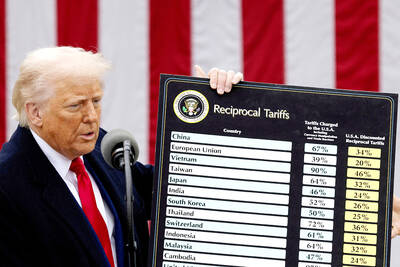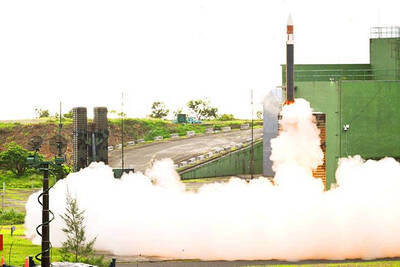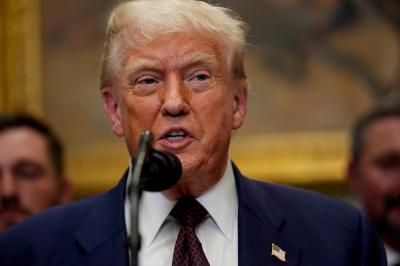North Korea said yesterday it was readying to launch a satellite, a move that the US and its allies believe could actually be a long-range missile test.
Just days after US Secretary of State Hillary Clinton warned Pyongyang to avoid any provocations, the country said preparations were under way for a rocket launch to put a communications satellite into orbit.
South Korea indicated a new round of sanctions would follow if the country goes ahead with a launch.
Pyongyang has previously tested missiles under the guise of launching a satellite, and analysts have said recent comments from the North indicated it was on the verge of another attention-grabbing test.
“When this satellite launch proves successful, the nation’s space science and technology will make another giant stride forward in building an economic power,” the country’s national space committee said.
North Korea first tested its longest-range Taepodong-2 missile in 2006, the same year it shocked the world by testing an atom bomb, but the missile — said to be capable of reaching Alaska — blew up after just 40 seconds.
South Korean Defense Minister Lee Sang-hee challenged the North to present evidence it was launching a satellite, not a missile.
“Regardless whether the North launches a satellite or tests a long-range missile, it would pose a security threat to the South as the technology involved is about the same,” he told parliament.
South Korea will “trace its trajectory, assuming it is a long-range missile,” Lee said.
Some analysts said the North would indeed launch a satellite but that the technology could easily be applied to a long-range missile. Experts do not know whether Pyongyang has the technology to fit a nuclear warhead to its missiles.
“If you put a warhead [on it] instead of a satellite, it’s a long-range missile. The North is now seeking to show off its delivery capability,” said Baek Seung-joo of the Korea Institute for Defense Analyses.
The North did not say when the launch would be made, but Baek said it may take place around the time of the North’s parliamentary elections on March 8.

WAITING GAME: The US has so far only offered a ‘best rate tariff,’ which officials assume is about 15 percent, the same as Japan, a person familiar with the matter said Taiwan and the US have completed “technical consultations” regarding tariffs and a finalized rate is expected to be released soon, Executive Yuan spokeswoman Michelle Lee (李慧芝) told a news conference yesterday, as a 90-day pause on US President Donald Trump’s “reciprocal” tariffs is set to expire today. The two countries have reached a “certain degree of consensus” on issues such as tariffs, nontariff trade barriers, trade facilitation, supply chain resilience and economic security, Lee said. They also discussed opportunities for cooperation, investment and procurement, she said. A joint statement is still being negotiated and would be released once the US government has made

NEW GEAR: On top of the new Tien Kung IV air defense missiles, the military is expected to place orders for a new combat vehicle next year for delivery in 2028 Mass production of Tien Kung IV (Sky Bow IV) missiles is expected to start next year, with plans to order 122 pods, the Ministry of National Defense’s (MND) latest list of regulated military material showed. The document said that the armed forces would obtain 46 pods of the air defense missiles next year and 76 pods the year after that. The Tien Kung IV is designed to intercept cruise missiles and ballistic missiles to an altitude of 70km, compared with the 60km maximum altitude achieved by the Missile Segment Enhancement variant of PAC-3 systems. A defense source said yesterday that the number of

‘CRUDE’: The potential countermeasure is in response to South Africa renaming Taiwan’s representative offices and the insistence that it move out of Pretoria Taiwan is considering banning exports of semiconductors to South Africa after the latter unilaterally downgraded and changed the names of Taiwan’s two representative offices, the Ministry of Foreign Affairs (MOFA) said yesterday. On Monday last week, the South African Department of International Relations and Cooperation unilaterally released a statement saying that, as of April 1, the Taipei Liaison Offices in Pretoria and Cape Town had been renamed the “Taipei Commercial Office in Johannesburg” and the “Taipei Commercial Office in Cape Town.” Citing UN General Assembly Resolution 2758, it said that South Africa “recognizes the People’s Republic of China (PRC) as the sole

Taiwanese exports to the US are to be subject to a 20 percent tariff starting on Thursday next week, according to an executive order signed by US President Donald Trump yesterday. The 20 percent levy was the same as the tariffs imposed on Vietnam, Sri Lanka and Bangladesh by Trump. It was higher than the tariffs imposed on Japan, South Korea and the EU (15 percent), as well as those on the Philippines (19 percent). A Taiwan official with knowledge of the matter said it is a "phased" tariff rate, and negotiations would continue. "Once negotiations conclude, Taiwan will obtain a better